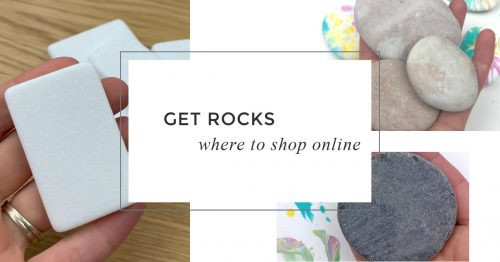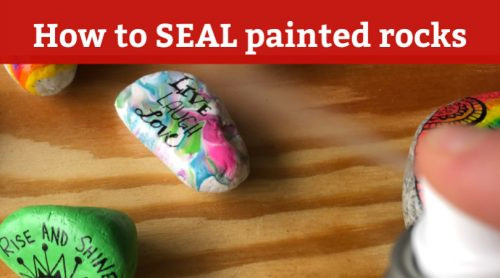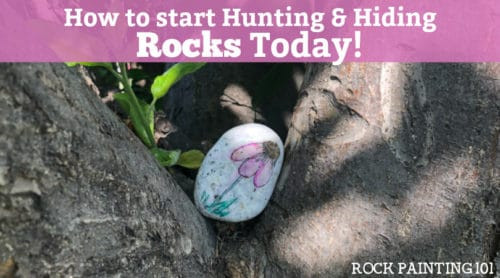Making painted rocks is a fun and creative hobby that’s perfect for all ages. At rockscapes.net, we’ll walk you through everything you need to know about rock painting ideas, from finding the perfect stones to sealing your finished designs. Get ready to unleash your inner artist and discover the joy of transforming ordinary rocks into colorful masterpieces, creating delightful rock art and unique stone crafts.
1. Finding the Perfect Rocks for Painting
Do you know where to find the best rocks for painting? The first step in creating beautiful painted rocks is sourcing the right materials.
Collecting rocks can be half the fun, however, ensure that you are following local laws. Taking one or two might not be a big deal, but once you start painting you don’t want to be taking too many stones away from nature. Instead, consider these options:
1.1 Landscaping Supply Shops
What is it: Visiting local landscaping supply shops is often the most affordable way to acquire rocks.
Benefits: These shops offer natural-looking stones in various sizes and colors.
What to consider: You’ll need to sort through the piles yourself, but many find this to be an enjoyable treasure hunt. Prices can vary, and some shops may even offer rocks for free.
1.2 Online Retailers
What is it: Ordering rocks online provides convenience and access to a wider selection.
Benefits: This option is ideal if you prefer specific types of rocks or cannot easily access local suppliers.
What to consider: rockscapes.net recommends exploring online options for unique stones that are perfect for painting.
1.3 Making Your Own Rocks
What is it: Creating your own stones offers complete control over size, shape, and color.
Benefits: This method is perfect for crafters who want uniformity in their rock painting projects.
What to consider: Although not for everyone, this option allows for a customized approach to rock crafting.
 Landscaping rocks ideal for painting with diverse shapes and sizes
Landscaping rocks ideal for painting with diverse shapes and sizes
2. Preparing Your Rocks for Painting
Are you ready to prepare your rocks for painting? Cleaning and prepping your stones properly ensures that the paint adheres well and your designs last. Follow these steps:
2.1 Washing the Rocks
Why is this important: The best way to clean your rocks is with a vegetable brush and warm running water. Scrub them like potatoes to remove any dirt, debris, or loose particles.
How to do it: Use a firm vegetable brush to scrub each rock thoroughly under warm running water. This step removes any dirt, moss, or loose particles that could interfere with paint adhesion.
Additional tips: According to research from Arizona State University’s School of Earth and Space Exploration, in July 2025, P provides Y) and ensure that you clean the rocks thoroughly to remove any contaminants that may affect the paint’s adherence.
2.2 Drying the Rocks
Why is this important: Make sure they dry completely before painting. This doesn’t take very long but does vary based on the size and thickness of your rocks.
How to do it: Arrange the cleaned rocks on a towel and allow them to air dry completely. This prevents water from interfering with the paint and ensures a smooth, even application.
Additional tips: Place the rocks in a well-ventilated area to speed up the drying process. You can also use a clean, dry cloth to pat them dry.
3. Selecting Your Rock Painting Supplies
What supplies do you need for rock painting? Choosing the right paint, brushes, and other materials can significantly impact the quality of your painted rocks. Consider these options:
3.1 Types of Paint
Acrylic Paints: These are popular for their vibrant colors, durability, and ease of use. They dry quickly and adhere well to rock surfaces.
Paint Pens (Posca Pens): Paint pens offer precision and control, making them ideal for detailed designs and intricate patterns. They come in various colors and tip sizes.
Specialty Paints (Glow-in-the-Dark, Metallic): These paints add unique effects to your rock art. Glow-in-the-dark paint creates a fun, whimsical look, while metallic paints add shimmer and shine.
3.2 Brushes
Synthetic Brushes: These are versatile and work well with acrylic paints. Choose a variety of sizes, including fine-tipped brushes for details and larger brushes for base coats.
Detail Brushes: Fine-tipped brushes are essential for adding intricate details, outlining designs, and creating delicate patterns.
Foam Brushes: These are great for applying smooth, even base coats of paint.
3.3 Other Essential Supplies
Palette or Paint Tray: A palette or paint tray keeps your paints organized and prevents them from drying out.
Water Container: Keep a container of clean water nearby for rinsing your brushes.
Paper Towels: Use paper towels to wipe excess paint from your brushes and clean up spills.
Sealant: A sealant protects your painted rocks from the elements and prevents the paint from chipping or fading.
Pencils and Erasers: Use a pencil to sketch your design onto the rock before painting. An eraser allows you to correct any mistakes.
 Rock painting supplies including acrylic paints, brushes, and paint pens
Rock painting supplies including acrylic paints, brushes, and paint pens
4. Rock Painting Techniques: Step-by-Step
How do you paint rocks with precision and creativity? Follow these steps to bring your rock painting ideas to life:
4.1 Base Coating
Why is this important: Applying a base coat provides a smooth, even surface for your design and helps the colors stand out.
How to do it: Use a foam brush or a larger synthetic brush to apply a thin, even layer of paint to the entire rock. Allow the base coat to dry completely before moving on to the next step.
Additional tips: Choose a base coat color that complements your design. White is a popular choice as it makes the colors pop, but you can also use other light colors or even black for a dramatic effect.
4.2 Sketching Your Design
Why is this important: Sketching your design onto the rock helps you plan your composition and ensures that your final result matches your vision.
How to do it: Use a pencil to lightly sketch your design onto the base coat. Don’t press too hard, as you want to be able to erase any mistakes easily.
Additional tips: If you’re not confident in your drawing skills, you can use stencils or transfer paper to create your design.
4.3 Painting Your Design
Why is this important: This is where your creativity comes to life. Use your chosen paints and brushes to fill in your design.
How to do it: Start with the larger areas of your design and work your way down to the smaller details. Use fine-tipped brushes for intricate patterns and outlines.
Additional tips: Take your time and apply thin, even layers of paint. Allow each layer to dry completely before adding the next. This prevents the colors from bleeding and ensures a crisp, clean result.
4.4 Adding Details and Embellishments
Why is this important: Adding details and embellishments can take your painted rocks to the next level.
How to do it: Use paint pens, fine-tipped brushes, or specialty paints to add details such as dots, lines, patterns, and highlights.
Additional tips: Consider using glitter, beads, or other embellishments to add texture and visual interest to your rocks.
5. Sealing Your Painted Rocks for Protection
How do you protect your painted rocks from the elements? Sealing your painted rocks is crucial for preserving your artwork and preventing it from fading, chipping, or being damaged by the weather.
5.1 Choosing the Right Sealer
Acrylic Sealers: These sealers provide a durable, water-resistant finish that protects your painted rocks from the elements. They come in various finishes, including glossy, matte, and satin.
Polyurethane Sealers: Polyurethane sealers offer excellent protection against UV rays, moisture, and abrasion. They are ideal for rocks that will be placed outdoors.
Epoxy Resins: Epoxy resins create a thick, glossy, glass-like finish that is highly durable and water-resistant. They are best suited for rocks that will be used as decorative items indoors.
5.2 Applying the Sealer
Spray-On Sealers: Spray-on sealers are easy to apply and provide an even coating. Hold the can about 10-12 inches away from the rock and spray in a sweeping motion. Apply several thin coats, allowing each coat to dry completely before adding the next.
Brush-On Sealers: Brush-on sealers are applied with a brush. Use a soft, synthetic brush and apply a thin, even layer of sealer to the entire rock. Avoid applying too much sealer, as this can cause drips and runs.
Resin Sealers: Resin sealers require mixing two components together before application. Follow the manufacturer’s instructions carefully and pour the resin over the rock, spreading it evenly with a brush or spatula. Allow the resin to cure completely before handling the rock.
5.3 Safety Precautions
Ventilation: Always apply sealers in a well-ventilated area or outdoors.
Protective Gear: Wear gloves and a mask to protect your skin and respiratory system from the fumes.
Manufacturer’s Instructions: Follow the manufacturer’s instructions carefully for proper application and drying times.
 Learn how to seal painted rocks with these simple techniques. There are a lot of different variables that go into properly sealing your painted rocks. These tips and step by step instructions will break it down so you can paint rocks for outdoors. #rockpainting101
Learn how to seal painted rocks with these simple techniques. There are a lot of different variables that go into properly sealing your painted rocks. These tips and step by step instructions will break it down so you can paint rocks for outdoors. #rockpainting101
6. Creative Rock Painting Ideas and Inspiration
Looking for rock painting ideas? Here are some creative ideas to spark your imagination:
6.1 Nature-Inspired Designs
Animals: Paint animals such as ladybugs, butterflies, birds, or cats onto your rocks.
Flowers: Create floral designs using vibrant colors and intricate details.
Landscapes: Paint miniature landscapes featuring mountains, trees, and sunsets.
6.2 Abstract and Geometric Patterns
Mandalas: Create intricate mandala designs using dots, lines, and geometric shapes.
Geometric Patterns: Experiment with geometric patterns such as stripes, triangles, and circles.
Abstract Art: Let your creativity flow and create abstract designs using bold colors and fluid lines.
6.3 Inspirational Quotes and Messages
Positive Affirmations: Paint rocks with positive affirmations such as “Believe,” “Dream,” or “Inspire.”
Inspirational Quotes: Write inspirational quotes from famous authors, poets, or leaders onto your rocks.
Kindness Messages: Spread kindness by painting rocks with messages such as “Be Kind,” “Smile,” or “You Are Loved.”
6.4 Holiday and Seasonal Themes
Halloween: Paint spooky Halloween-themed rocks with ghosts, pumpkins, and bats.
Christmas: Create festive Christmas rocks with snowmen, reindeer, and Santa Claus.
Easter: Paint colorful Easter rocks with bunnies, eggs, and chicks.
6.5 Tips for Beginners
Start Simple: Begin with simple designs and gradually work your way up to more complex patterns.
Use Stencils: Use stencils to create precise shapes and patterns.
Practice Regularly: The more you practice, the better you’ll become at rock painting.
Have Fun: Don’t be afraid to experiment and let your creativity shine.
 Rock painting ideas featuring nature-inspired designs and positive messages
Rock painting ideas featuring nature-inspired designs and positive messages
7. Sharing and Displaying Your Painted Rocks
What do you do with your finished painted rocks? Here are some ideas for sharing and displaying your creations:
7.1 Hiding Rocks in Public Places
Rock Hiding: Hide your painted rocks in parks, gardens, or other public places for others to find.
Local Rock Groups: Join local rock painting groups on social media to share your creations and participate in rock hiding events.
Hashtags: Add hashtags to your rocks so that finders can share their discoveries online.
7.2 Gifting Your Painted Rocks
Personalized Gifts: Give your painted rocks as personalized gifts to friends, family, or colleagues.
Special Occasions: Create painted rocks to commemorate special occasions such as birthdays, weddings, or anniversaries.
Random Acts of Kindness: Leave painted rocks as random acts of kindness for strangers to find.
7.3 Displaying Rocks at Home
Garden Decor: Use your painted rocks to decorate your garden or outdoor space.
Indoor Decor: Display your painted rocks on shelves, mantels, or windowsills.
Rock Collections: Create a rock collection and display it in a glass jar or display case.
 Rock hunting is all the rage and these tips will have you collecting like a pro! From how to find rocks to how to hide them. We have the answers to your questions. #rockhunting #rockhiding #rockpainting #summeractivities #summer #rockpainting101
Rock hunting is all the rage and these tips will have you collecting like a pro! From how to find rocks to how to hide them. We have the answers to your questions. #rockhunting #rockhiding #rockpainting #summeractivities #summer #rockpainting101
8. Advanced Rock Painting Techniques
Want to take your rock painting skills to the next level? Here are some advanced techniques to explore:
8.1 Dot Painting
What is it: Dot painting involves creating designs using dots of various sizes and colors.
How to do it: Use paint pens or fine-tipped brushes to create intricate dot patterns on your rocks.
Tips: Practice creating consistent dots and experiment with different color combinations.
8.2 Mandala Art
What is it: Mandala art involves creating symmetrical, geometric designs that radiate from a central point.
How to do it: Use a compass and ruler to create a basic mandala grid on your rock. Then, fill in the grid with intricate patterns and details using paint pens or fine-tipped brushes.
Tips: Start with a simple design and gradually work your way up to more complex patterns.
8.3 Blending Paints
What is it: Blending paints involves creating smooth transitions between colors on your rocks.
How to do it: Apply two or more colors of paint to your rock and then use a soft brush to blend the colors together.
Tips: Work quickly and use a light touch to avoid muddying the colors.
8.4 Pour Painting
What is it: Pour painting involves pouring acrylic paints onto your rocks to create abstract designs.
How to do it: Mix acrylic paints with a pouring medium and then pour the paints onto your rocks in a variety of patterns.
Tips: Experiment with different pouring techniques and color combinations to create unique effects.
9. Choosing the Right Rocks for Different Projects
Which rocks work best for specific painting projects? The type of rock you choose can impact the final result of your painted masterpiece. Here’s a guide to help you select the best rocks for various projects:
9.1 Smooth Rocks
Ideal For: Detailed designs, intricate patterns, and smooth color gradients.
Why: The smooth surface allows for easy paint application and prevents the paint from bleeding or smearing.
Examples: River rocks, polished stones.
9.2 Rough Rocks
Ideal For: Rustic, textured designs, and natural-looking patterns.
Why: The rough surface adds depth and dimension to your artwork and creates a unique tactile experience.
Examples: Lava rocks, sedimentary rocks.
9.3 Flat Rocks
Ideal For: Landscape scenes, portrait paintings, and displaying on shelves or walls.
Why: The flat surface provides a stable base for painting and allows your artwork to stand upright.
Examples: Slate rocks, flagstones.
9.4 Large Rocks
Ideal For: Garden decorations, outdoor sculptures, and statement pieces.
Why: The large size makes your artwork more visible and impactful, and allows you to create intricate designs on a grand scale.
Examples: Boulders, large river rocks.
9.5 Small Rocks
Ideal For: Miniature paintings, jewelry making, and hiding in public places.
Why: The small size makes your artwork portable and easy to share, and allows you to create delicate designs with precision.
Examples: Pebbles, small river rocks.
10. Preserving and Maintaining Your Painted Rocks
How do you ensure your painted rocks last for years? Proper care and maintenance can help preserve the beauty of your painted rocks for years to come. Here are some tips to keep them in top condition:
10.1 Cleaning
How to Clean: Gently wipe your painted rocks with a soft, damp cloth to remove any dirt or dust.
What to Avoid: Avoid using harsh chemicals or abrasive cleaners, as these can damage the paint and sealant.
10.2 Storage
Indoor Storage: Store your painted rocks indoors in a cool, dry place away from direct sunlight.
Outdoor Storage: If you display your painted rocks outdoors, choose a sheltered location that is protected from the elements.
10.3 Preventing Damage
Handling: Handle your painted rocks with care to avoid chipping or scratching the paint.
Sunlight: Prolonged exposure to direct sunlight can cause the paint to fade over time.
Extreme Temperatures: Avoid exposing your painted rocks to extreme temperatures, as this can cause the paint to crack or peel.
FAQ: Painted Rocks
Do you have questions about painted rocks? Here are some frequently asked questions to help you get started:
1. What kind of paint is best for painting rocks?
Acrylic paints are generally considered the best choice for painting rocks due to their durability, vibrant colors, and quick-drying properties.
2. How do I prepare rocks for painting?
Wash the rocks with warm water and a scrub brush to remove any dirt or debris. Allow the rocks to dry completely before painting.
3. Do I need to seal my painted rocks?
Yes, sealing your painted rocks is essential for protecting the paint from the elements and preventing it from chipping or fading.
4. What kind of sealant should I use for painted rocks?
Acrylic sealers, polyurethane sealers, and epoxy resins are all good choices for sealing painted rocks. Choose a sealant that is appropriate for your project and the environment in which the rocks will be displayed.
5. How do I apply sealant to painted rocks?
You can apply sealant to painted rocks using a spray-on sealer, a brush-on sealer, or a resin sealer. Follow the manufacturer’s instructions carefully for proper application and drying times.
6. Can I use paint pens to paint rocks?
Yes, paint pens are a great option for adding details and embellishments to your painted rocks. They offer precision and control, making them ideal for intricate designs.
7. How do I clean painted rocks?
Gently wipe your painted rocks with a soft, damp cloth to remove any dirt or dust. Avoid using harsh chemicals or abrasive cleaners.
8. Where can I find inspiration for rock painting designs?
You can find inspiration for rock painting designs online, in books, or by observing nature. Let your creativity flow and experiment with different colors, patterns, and themes.
9. Can I hide painted rocks in public places?
Yes, hiding painted rocks in public places is a fun way to spread joy and kindness. Be sure to check local regulations and guidelines before hiding rocks in your community.
10. How can I share my painted rocks with others?
You can share your painted rocks with others by hiding them in public places, gifting them to friends and family, or displaying them in your home or garden. You can also share photos of your creations on social media.
Painted rocks are more than just painted stones; they are expressions of creativity and joy. Whether you’re creating a tranquil garden display or hiding a cheerful surprise for a stranger to find, the possibilities are endless.
Ready to start your rock painting adventure? Visit rockscapes.net today for more inspiration, tips, and high-quality materials to bring your visions to life. Explore our curated collections, connect with fellow rock artists, and let your imagination run wild. Let rockscapes.net be your guide to transforming ordinary stones into extraordinary works of art.
Address: 1151 S Forest Ave, Tempe, AZ 85281, United States
Phone: +1 (480) 965-9011
Website: rockscapes.net
